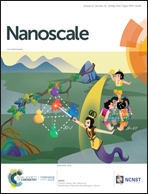A highly sensitive self-enhanced aptasensor based on a stable ultrathin 2D metal–organic layer with outstanding electrochemiluminescence property†
Abstract
3D bulk metal–organic frameworks (MOFs) have received growing interest in electrochemiluminescence (ECL) assays because they can provide a high specific surface for loading a large quantity of ECL luminophores, but the ECL efficiency of bulk MOFs is still low since some interior luminophores are difficult to be excited. Herein, an ultrathin 2D metal–organic layer (MOL) for grafting self-enhanced ruthenium complexes (Ru-L-Lys) was first synthesized to greatly increase the utilization ratio of luminophores. Compared with 3D bulk MOFs, ultrathin 2D MOL could provide more accessible postmodification sites for grafting the Ru-L-Lys complexes; the self-enhanced Ru-L-Lys complexes on MOL were easily excited by electrons due to the shortened ion/electron-transport distance and the removal of diffusion barriers. Furthermore, the electron transfer path between the Ru(II) luminophore and coreactant (L-Lys) was shortened and the energy loss of the luminophores decreased, which significantly improved the ECL efficiency. As expected, our work manifested that the Zr-MOL's loading amount of Ru-L-Lys was about 1.23-fold higher than that of a 3D bulk Zr-MOF, and the ECL intensity and efficiency of Ru-L-Lys-Zr-MOL were around 93.45-fold and 1.64-fold higher than those of control Ru-L-Lys-Zr-MOF, respectively. Considering all of these merits, in this work, we utilized the prepared Ru-L-Lys-Zr-MOL as a highly efficient ECL indicator for the first time to fabricate a highly sensitive self-enhanced aptasensor for mucin 1 (MUC1) determination. The proposed aptasensor showed high sensitivity with a linear range from 1 fg mL−1 to 100 pg mL−1 with a detection limit of 0.72 fg mL−1; it also exhibited excellent specificity and stability. It is noteworthy that this work not only provides a new strategy to design and synthesize high-performance ECL materials, but also opens a new way to develop ultrasensitive ECL sensors for bioanalysis.



 Please wait while we load your content...
Please wait while we load your content...